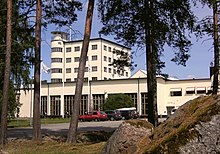Stockholm Vatten och Avfall
Stockholm Vatten och Avfall (German Stockholm Water and Waste ) is the waterworks for Stockholm and the surrounding area and has also been responsible for the city's waste disposal since 2017 . The waterworks are 98% owned by Stockholm Municipality through Stockholms Stadshus AB and 2% owned by Huddinge Municipality . Stockholm Vatten owns and maintains the pipeline network for drinking water and wastewater , as well as pumping stations , water storage and sewage treatment plants in the greater Stockholm area. Within the remit of Stockholm Vatten also maintenance and restoration of lakes in fall Stockholm County . Stockholm Vatten produces the drinking water for over one million people in the region.
history
The supply of healthy drinking water in Stockholm was not always as good as it is today. Until the 1860s, the people of Stockholm got their drinking water from their own wells or from nearby bodies of water, which were becoming more and more polluted, which led to the outbreak of cholera and other diseases. In the middle of the 19th century Stockholm was one of the most unhealthy cities in Europe. In 1861, as one of the last capitals in Europe, the city's first waterworks, the Skanstullsverket , was inaugurated on Årstaviken . The better hygiene showed a direct positive result, the mortality fell within 30 years with 50% from 34 to 17 deaths per thousand inhabitants with a simultaneous population increase of 46%.
Norsborg's waterworks
Soon the Skanstullsverket was no longer sufficient to supply Stockholm with clean drinking water, and the water in Årstaviken no longer had the desired quality as raw water. Therefore, in 1905, the waterworks in Norsborg ( Botkyrka municipality ), Norsborgsverket in the south of Stockholm, was built. From now on the raw water was taken from Mälaren , and it is still like that today. Norsborgsverket was expanded in 1953, 1964 and 1975, it is the largest waterworks in the region and supplies 60% of the population. The daily production is around 153,000 m 3 of drinking water, the total capacity is 240,000 m 3 .
Lovö waterworks
In 1933 the Lovö waterworks, a modern building by the architect Paul Hedqvist, opened . Lovö vattenverk is located on the Mälar island Lövön near Ekerö , and was supposed to supply the northern part of the fast growing city of Stockholm with drinking water. Today, Lovö vattenverk provides 40% of the region with drinking water. The raw water is taken from the Mälaren at depths of five, ten and 23 meters, the capacity is 275,000 m 3 per day and normal production is 133,000 m 3 of drinking water per day.
Bornsjön
The Bornsjö in the town of Salem in southern Stockholm is a water reserve and Stockholm's drinking water reserve in case of Mälaren becomes dirty. In an emergency, the lake could provide the city with drinking water for a few months. The 6.7 km 2 Bornsjön and its surroundings were placed under nature protection as early as 1920 , today the lake and its surroundings are maintained and looked after by Stockholm Vatten . Bathing and fishing in the lake is prohibited. The lake is closed to private boat traffic, and even ice skating is prohibited.
Cleaning works
In 1872 the first sewer pipes were pulled through Stockholm and shortly before the turn of the century 1900 the first water closets were installed, which increased the need for a functioning sewage system with sewage treatment plants. In the 1950s, dry toilets were still common in Stockholm's city center, the last only disappeared with the Norrmalmsregelingen (redesign of Stockholm city) in the 1960s and 1970s. The first modern sewage treatment plant was put into use in Bromma in 1934 . Today Stockholm Vatten has two more sewage treatment plants, in Henriksdal (1941) and Loudden (1950). These clean around 400,000 m 3 of wastewater, and the resulting sludge is used to produce biogas , among other things . In 2000 it was possible to produce 11.8 million m 3 of biogas, which is used for heating, electricity production and vehicle gas.
More facts
According to Statistiska Central Byrån, SCB, 2002:
- Line length: 2,100 km
- Average daily production: 286,000 m 3
- Daily production maximum: 515,000 m 3
- Pumping stations: 58 St.
- Water storage: 11 pcs.
- Consumption per person and day: 200 liters
Footnotes
- ^ Vatten i Stockholm, Stockholms Miljöcenter, 2002, page 7
- ^ Sveriges National Atlas: "Befolkningen", page 60
- ^ Vatten i Stockholm, Stockholms Miljöcenter, 2002, page 11
- ^ Vatten i Stockholm, Stockholms Miljöcenter, 2002, page 12
- ^ Vatten i Stockholm, Stockholms Miljöcenter, 2002, pages 16-18
- ^ Vatten i Stockholm, Stockholms Miljöcenter, 2002, page 18
- ^ Vatten i Stockholm, Stockholms Miljöcenter, 2002, page 15



